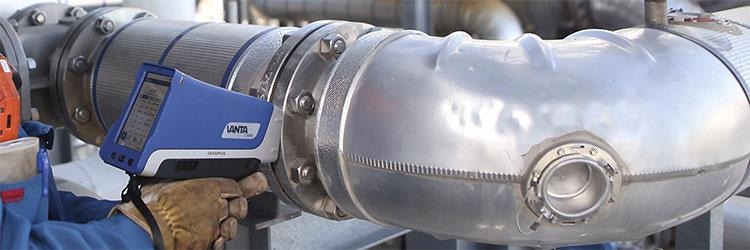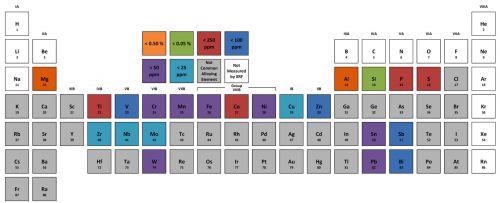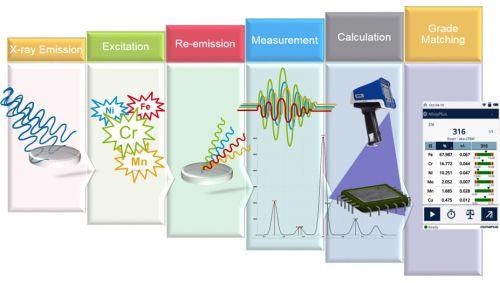A critical part of manufacturing, petrochemical production, and consumer products is positive material identification (PMI). Helping ensure that the correct metal or alloy is used in the correct place and that there are no aberrations in the material’s composition (such as contamination with heavy metals) are both critical. An effective and simple-to-use method for component PMI is X-ray fluorescence (XRF), which can be used to confirm that the right metal or alloy is being used.

Image Credit: Evident Corporation
Answers can be obtained quickly with minimal sample preparation using handheld XRF. The most common application of XRF is alloy identification. With the Vanta™ XRF analyzer, grade identification can typically be carried out in as little as 1–2 seconds.
Material Composition
More than 90% of the elements in the periodic table can be quantified with handheld XRF, which covers most of the elements used in commercial alloys.
Representative1 limits of detection for common alloying elements are shown in Figure 1. This detection capacity allows the XRF analyzer to make positive grade matches for aluminum alloys, stainless steels, chrome-moly alloys, many piping and flange materials, brasses, bronzes and other copper alloys, solders, titanium alloys, tool steels, and many so-called “super alloys” based on nickel or cobalt.

Figure 1: Representative limits of detection for common alloying elements1. Image Credit: Evident Corporation
Elements lighter than magnesium, such as lithium, beryllium, and carbon, cannot be directly measured with handheld XRF. These elements are sometimes relevant in applications such as:
- Lithium in some aerospace aluminum alloys
- Beryllium in some copper alloys
- Carbon in many low-alloy steels
That said, the composition of their other alloying elements can be used as a basis to identify the grade of many of these alloys. However, other analytical methods are needed if light elements require quantifying.
Sample Condition
XRF analyzers work in the following way:
- X-rays are sent out
- X-rays come back to a detector
- The data is processed using complicated math
- Grade identification is displayed, as shown in Figure 2.
XRF is a surface measurement technique, and so in light alloys, for example, aluminum, it can only measure the top few hundred microns of the sample. It measures less than a hundred microns into the sample for main metals, such as iron or copper, and it only measures the top tens of microns for dense materials, such as gold or lead.

Figure 2: The process of positive material identification by X-ray fluorescence. Image Credit: Evident Corporation
Since XRF is a surface measurement technique, the material’s surface must be an accurate reflection of the bulk composition. The analysis can be dramatically skewed by surface contamination, such as paint, sealers, and galvanization. Similarly, a positive material identification can be prevented by residue from sandblasting or shot blasting, grinding, or even dirt. Therefore, before testing a sample with XRF, it must be clean.
A low-wattage X-ray tube is used in handheld XRF analyzers. The analyzer should be close to the sample, ideally in direct contact, as the X-rays going out and coming back are low wattage. If the sample has a complex geometry, then this can prove a challenge. However, Vanta™ analyzers feature a narrow profile, which enables the instrument to get very close to oblique samples, such as a flange welded to a pipe at 90 degrees.
Sample Surface Temperature
Variations in sample temperatures leave the X-ray physics of XRF essentially unchanged. Regardless of environmental conditions, the Vanta™ XRF analyzer can provide reliable performance. The instrument can operate without thermal drift or performance deterioration in operating temperatures between -10 °C and 50 °C (14 °F–122 °F).2
Samples can be measured at temperatures up to approximately 100 °C (212 °F) by Vanta analyzers without modification. At higher temperatures, the Prolene film that makes up part of the instrument window is susceptible to damage. An alternative face plate offered by Evident for hot testing includes a Kapton window, enabling the instrument to measure samples up to 315 °C (600 °F).
Conclusion
In terms of positive material identification, X-ray fluorescence is a powerful method. PMI can be performed quickly and confidently with its broad analytical capabilities and ease-of-use. It aids in the prevention of loss of production, and, most importantly, it can help prevent injuries or loss of life that may result from using the wrong component material.
References
[1] Limits of detection are affected by testing time, sample type, and the combination of interfering elements. These values are intended to be representative but may vary with samples and test conditions. They are provided simply as a guide.
[2] With an optional fan. The fan assembly is IP56 rated. It operates continuously at 33 °C without the fan.

This information has been sourced, reviewed and adapted from materials provided by Evident Corporation.
For more information on this source, please visit https://www.evidentscientific.com/en/